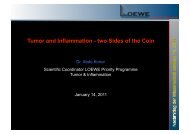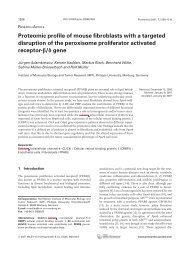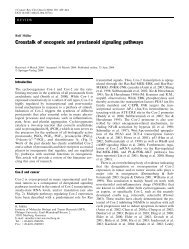PDF-File - IMT - Philipps-Universität Marburg
PDF-File - IMT - Philipps-Universität Marburg
PDF-File - IMT - Philipps-Universität Marburg
You also want an ePaper? Increase the reach of your titles
YUMPU automatically turns print PDFs into web optimized ePapers that Google loves.
THE JOURNAL OF BIOLOGICAL CHEMISTRY Vol. 270, No. 42, Issue of October 20, pp. 24989–24994, 1995<br />
© 1995 by The American Society for Biochemistry and Molecular Biology, Inc. Printed in U.S.A.<br />
Functional Analyses of the Transcription Factor Sp4 Reveal<br />
Properties Distinct from Sp1 and Sp3*<br />
(Received for publication, July 12, 1995)<br />
Gustav Hagen‡, Jörg Dennig, Alexandra Preiß, Miguel Beato, and Guntram Suske§<br />
From the Institut für Molekularbiologie und Tumorforschung, <strong>Philipps</strong>-Universität <strong>Marburg</strong>, Emil-Mannkopff-Strasse 2,<br />
D-35037 <strong>Marburg</strong>, Germany<br />
Sp4 is a human sequence-specific DNA binding protein<br />
with structural features similar to those described<br />
for the transcription factors Sp1 and Sp3. These three<br />
proteins contain two glutamine-rich regions and a<br />
highly conserved DNA binding domain composed of<br />
three zinc fingers. Consistently, Sp1, Sp3, and Sp4 do<br />
have the same DNA binding specificities. In this report,<br />
we have embarked on a detailed analysis of the transcriptional<br />
properties of Sp4 in direct comparison to<br />
Sp1 and Sp3. Cotransfection experiments into Drosophila<br />
SL2 cells lacking endogenous Sp factors demonstrate<br />
that Sp4 is an activator protein like Sp1. However, in<br />
contrast to Sp1, Sp4 is not able to act synergistically<br />
through adjacent binding sites. The transactivation<br />
function of Sp4 resides, like that of Sp1, in the N-terminal<br />
glutamine-rich region. Sp4 can function as a target<br />
for the Sp1 activation domains in a superactivation assay,<br />
suggesting that the activation domains of Sp1 and<br />
Sp4 are functionally related. Furthermore, we show that<br />
Sp4-mediated transcriptional activation can be repressed<br />
by Sp3. Taken together, our results demonstrate<br />
that the transcription factor Sp4 exhibits specific functional<br />
properties distinct from Sp1 and Sp3.<br />
The properly timed and coordinated expression of eukaryotic<br />
genes requires the combinatorial action of multiple sequencespecific<br />
DNA binding proteins. These transcription factors recognize<br />
distinct promoter and enhancer elements, thereby acting<br />
positively or negatively on transcription. One of the first<br />
and best characterized mammalian transcription factors was<br />
Sp1 (1, 2) which binds to GC boxes and related motifs (3)<br />
present in many promoters. However, Sp1 is not the only protein<br />
binding to and acting through these DNA motifs. At least<br />
two other more recently cloned human proteins, designated<br />
Sp3 and Sp4, do bind with identical affinity to the same recognition<br />
sequence as Sp1 (4). Note that Sp2, yet another factor<br />
homologous to Sp1, seems to have DNA binding specificities<br />
different from Sp1, Sp3, and Sp4 (5).<br />
Sp1, Sp3, and Sp4 represent a family of GC box binding<br />
proteins with very similar structural features. In addition to<br />
the highly conserved DNA binding domain close to the C terminus,<br />
all three proteins contain two glutamine- and serine/<br />
threonine-rich amino acid stretches in the N-terminal part of<br />
* This work was supported by a grant from the Deutsche Forschungsgemeinschaft.<br />
The costs of publication of this article were defrayed in<br />
part by the payment of page charges. This article must therefore be<br />
hereby marked “advertisement” in accordance with 18 U.S.C. Section<br />
1734 solely to indicate this fact.<br />
‡ Present address: MGC Dept. of Cell Biology and Genetics, Erasmus<br />
University, Dr Molewaterplein 50, 3000 DR Rotterdam, The Netherlands.<br />
§ To whom correspondence should be addressed. Tel.: 49-6421-<br />
286697; Fax: 49-6421-285398; E-mail: Suske@imt.uni-marburg.de.<br />
24989<br />
the molecule. For Sp1, the glutamine-rich domains have been<br />
identified as transactivation domains (2, 6). Two additional<br />
domains of Sp1 (C and D) located adjacent to the zinc finger<br />
region also influence the transcriptional activation function,<br />
one being weakly basic (C) and the other (D) showing no significant<br />
homology to known activation domains (6). The D<br />
domain of Sp1 plays a key role in mediating the ability of Sp1<br />
to activate transcription synergistically (7).<br />
The high degree of structural conservation between Sp1,<br />
Sp3, and Sp4 suggested that Sp3 and Sp4 do exert similar<br />
activation functions. A functional analysis of Sp3 using transfection<br />
experiments into mammalian cell lines and into Drosophila<br />
SL2 cells lacking endogenous Sp factors demonstrated,<br />
however, that Sp3 is not simply a functional equivalent of Sp1.<br />
Sp3 failed to activate Sp1-responsive promoter constructs. Instead,<br />
it repressed Sp1-mediated transcriptional activation<br />
(8–10), suggesting that Sp3 is an inhibitory member of the Sp<br />
family. The intriguing finding that Sp1 and Sp3 can exert<br />
opposite transcriptional regulation prompted us to analyze<br />
thoroughly the transcriptional properties of the Sp4 protein.<br />
We have performed cotransfection experiments into mammalian<br />
cells and into insect cells that lack endogenous Sp<br />
factors. Our studies demonstrate that Sp4 is an activator protein<br />
like Sp1. However, in contrast to Sp1, Sp4 is not able to act<br />
synergistically through adjacent binding sites. Moreover, Sp4-<br />
mediated activation is strongly enhanced (superactivated) in<br />
the presence of a non-DNA binding mutant of Sp1, suggesting<br />
that Sp1 can interact directly with Sp4. We show further that<br />
Sp4-mediated transcriptional activation is repressed by Sp3.<br />
Our results thus demonstrate that Sp4 exhibits a unique spectrum<br />
of functional properties distinct from those found for Sp1<br />
and Sp3.<br />
EXPERIMENTAL PROCEDURES<br />
Plasmid Constructions—In the Gal4-Sp expression vectors, the 147<br />
N-terminal codons of the yeast transcription factor Gal4 containing its<br />
DNA binding domain were fused to fragments coding for the N-terminal<br />
regions of Sp1, Sp3, and Sp4. Expression of the fusion proteins is driven<br />
by the SV40 promoter. The construction of the Gal4-Sp3 expression<br />
vector (pSG424-Gal4-Sp3) has been described (9). The Gal4-Sp1 and<br />
Gal4-Sp4 expression constructs (pSG424-Gal4-Sp1 and pSG424-Gal4-<br />
Sp4) were generated by the following strategies. For plasmid pSG424-<br />
Gal4-Sp1, the region encoding the 603 N-terminal amino acids of Sp1<br />
was obtained as a SmaI-XbaI fragment from CMV-Sp1-DBD (8). To<br />
generate the Gal4-Sp1 fusion protein, the BamHI (blunted)-XbaI fragment<br />
of pSG424(1–147)-Sp1 (encoding the A domain of Sp1 (11)) was<br />
replaced by the SmaI-XbaI Sp1 fragment leading to pSG424-Gal4-Sp1.<br />
For plasmid pSG424-Gal4-Sp4, we first constructed a fingerless mutant<br />
of Sp4 encoding the 620 N-terminal amino acids. A 1.9-kb 1 HindIII-SfuI<br />
fragment from pBS-Sp4 (A8.68 in pKS (4)) was cloned into the HindIII<br />
site of pRC/CMV (Invitrogen) leading to pRC/CMV-Sp4-DBD. For this,<br />
we fused HindIII linkers containing stop codons in all three reading<br />
1 The abbreviations used are: kb, kilobase(s); CAT, chloramphenicol<br />
acetyltransferase.
24990<br />
Functional Analyses of the Transcription Factor Sp4<br />
frames to the blunted SfuI sites of the Sp4 cDNA insert. To generate the<br />
Gal4-Sp4 fusion construct, the Sp1 encoding fragment in pSG424(1–<br />
147)-Sp1 was replaced by a 1.76-kb SauI (blunted)-XbaI fragment from<br />
pRC/CMV-Sp4-DBD.<br />
The reporter plasmid G5E1bSV is a derivative of the plasmid G5E1b<br />
(12) and was constructed as follows. The uteroglobin promoter in the<br />
plasmid pUG(395)CATSV (13) was replaced by a 130-base pair PstI-<br />
BamHI fragment from G5E1b containing five Gal4 binding sites fused<br />
to the E1bTATA box.<br />
Sp4 expression vectors for Drosophila melanogaster Schneider cells<br />
(SL2 cells) were generated as follows. The plasmid pPacSp4 was obtained<br />
by cloning a 3-kb HindIII-NotI fragment from pBS-Sp4 into the<br />
single BamHI site of pPac via decameric BamHI linkers. Sp4 expression<br />
plasmids containing the Ubx leader sequence (pPac773Sp4 and<br />
pPac747Sp4) were generated by replacing the Sp1 cDNA in pPacSp1 (6)<br />
by the 2.7-kb SmaI or the 2.6-kb blunted SauI-XhoI fragment, respectively,<br />
from the pBS-Sp4 plasmid A8O (4) via 8-mer and 12-mer XhoI<br />
linkers. The expression plasmids for Sp1 (pPacSp1) and fingerless Sp3<br />
(pPacSp3ZnD pPacSp3-DBD in Ref. 8) were described previously<br />
(6, 8). The expression plasmid for the fingerless Sp1 mutant<br />
(pPacSp1ZnD), in which the 165 C-terminal codons of Sp1 were removed,<br />
was obtained by replacing the Sp4 insert of pPac747Sp4 by a<br />
1.6-kb BamHI fragment of pPacSp1 leading to pPacSp1ZnD. The<br />
plasmid for the expression of the DNA binding domain of Sp3<br />
(pPacSp3DBD) was generated by replacing the NdeI-XbaI insert of an<br />
expression plasmid for dTAFII110 (pPacG4–110, kindly provided by R.<br />
Tjian) with a 0.8-kb NdeI-XbaI fragment obtained from pET-3c/A3O (4).<br />
Cell Culture, Transfections, and CAT Assays—Ishikawa cells were<br />
cultured in minimum essential medium Eagle as described previously<br />
(14). They were transfected by the DEAE-dextran method (15). Every<br />
plate (9 cm) received 2 g of G5E1bSV reporter, 2 g of Gal4-Sp<br />
expression plasmid, and 1 g of RSVLuc. Transfected cells were harvested<br />
for CAT assays 72 h after transfection. Variations in transfection<br />
efficiencies were corrected by determining the luciferase activities (16).<br />
SL2 cells (17) were maintained in Schneider medium supplemented<br />
with 10% fetal calf serum at 25 °C. 1 day prior to transfection, cells were<br />
plated onto 6-cm plastic dishes at a density of 4.3 10 6 cells per plate.<br />
Cells were transfected by the calcium phosphate method described by<br />
DiNocera and Dawid (18). Every plate received up to 14 g ofDNA<br />
including 4 g ofthe-galactosidase expression plasmid p97b as internal<br />
reference. Variable amounts of expression plasmids were compensated<br />
with the plasmid pPac. 24 h after addition of DNA, the medium<br />
was changed, and 24 h later the cells were washed twice with phosphate-buffered<br />
saline and harvested.<br />
For CAT assays, cells were suspended in 250 mM Tris/Cl, pH 7.8, and<br />
lysed by three rounds of freezing and thawing. CAT assays were carried<br />
out according to Gorman et al. (19). Protein concentrations in the CAT<br />
assays and reaction times were adjusted to bring the extent of CAT<br />
conversion into a range that is linear with the CAT enzyme concentration.<br />
CAT conversion was assayed by thin layer chromatography, and<br />
quantitation of acetylated and non-acetylated forms of [ 14 C]chloramphenicol<br />
was performed with an automated Imaging Scanner (United<br />
Technologies Packard). The ratio of acetylated to total chloramphenicol<br />
was displayed as percentage of conversion. The -galactosidase assays<br />
were performed according to Hall et al. (20). The values were used to<br />
normalize the CAT conversion data for plate to plate variations in<br />
transfection efficiency.<br />
Nuclear Extracts and Electrophoretic Mobility Shift Assays—Nuclear<br />
extracts from transfected Ishikawa and SL2 cells were prepared from<br />
one 10-cm plate according to Andrews and Faller (21). Gel retardation<br />
assays were essentially performed as described (22, 23) with oligonucleotides<br />
containing the Gal4 (24) or the GT box (4) binding site,<br />
respectively.<br />
The sequences of the oligonucleotides were as follows: GT box binding<br />
site, 5-AGCTTCCGTTGGGGTGTGGCTTCACGTCGA-3 and 3-<br />
TCGAAGGCAACCCCACACCGAAGTGCAGCT-5; Gal4 binding site,<br />
5-GCTTAGCGGAGTACTGTCCTCCGATCCC-3 and 3-CGAATCGC-<br />
CTCATGACAGGAGGCTAGGG-3; unspecific oligonucleotide, 5-CAG-<br />
CGACTAACATCGATCGC-3 and 3-GTCGCTGATTGTAGCTA-<br />
GCG-5.<br />
RESULTS<br />
Sp4 Is a Transcriptional Activator in SL2 Cells—To assess<br />
the activation properties of Sp4 under defined conditions, we<br />
performed cotransfection experiments into Drosophila Schneider<br />
cells (SL2 cells). SL2 cells are particularly suited to this<br />
task because they lack endogenous Sp-like activities (6). We<br />
FIG. 1. Transient expression of Sp1 and Sp4 proteins in SL2<br />
cells. Gel retardation assays were performed with crude nuclear extracts<br />
from SL2 cells. Cells were transfected with 8 g of pPac vector<br />
(lanes 1–3), 8 g of pPacSp4 (lanes 4–6), or 8 g of pPacSp1 (lanes 7–9).<br />
In lane 10, a bacterial extract containing Sp4 was used as control (4). All<br />
reactions contained 0.1 ng of labeled GT oligonucleotide. In lanes 2, 5,<br />
and 8, a 50-fold molar excess of a nonspecific oligonucleotide (U) and in<br />
lanes 3, 6, and 9, a 50-fold molar excess of unlabeled GT oligonucleotide<br />
(S) was included in the binding reaction. Arrows indicate the free<br />
oligonucleotide and specifically retarded protein-DNA complexes,<br />
respectively.<br />
constructed a Drosophila expression vector for Sp4 (pPacSp4)<br />
by fusing the appropriate Sp4 cDNA fragment to the Drosophila<br />
actin 5C promoter. First, we examined whether the level of<br />
expression of Sp4 is similar to Sp1 following transfection. For<br />
this, we performed electrophoretic mobility shift analyses with<br />
an oligonucleotide containing the 10-base pair GT motif as<br />
DNA probe (25). Specific complexes were generated with SL2<br />
lysates containing Sp1 and Sp4. However, the complex obtained<br />
with Sp4 was much weaker (Fig. 1), indicating that Sp4<br />
is expressed only moderately in transfected SL2 cells. In contrast,<br />
equal amounts of Sp1 and Sp3 expression plasmids gave<br />
roughly equivalent shifts (Ref. 8 and data not shown). A similar<br />
low expression of Sp4 was observed also when we provided a<br />
different translational start site by fusing the 773 or 747 C-<br />
terminal amino acids, respectively, of Sp4 to the Ubx leader<br />
sequence of pPacUbx (6). This finding suggests that the low<br />
expression of Sp4 does not reflect a weak translational start<br />
point of the Sp4 mRNA but is an intrinsic property of the Sp4<br />
protein sequence itself. It should be noted that rat Sp1 (26) is<br />
also expressed weakly in SL2 cells (data not shown), although<br />
the cDNA differs from human Sp1 only in 31 out of 788 residues.<br />
Our band shift assays thus show that different amounts<br />
of expression plasmids for Sp1 and Sp4 are required to ensure<br />
equal amounts of intact protein in the cell.<br />
To test the putative transcriptional activity of Sp4 in direct<br />
comparison with Sp1, we cotransfected expression vectors for<br />
Sp4 and Sp1 together with BCAT-1 as test promoter construct<br />
(see Fig. 2A). BCAT-1 contains a single Sp1 binding site from<br />
the HIV promoter fused to the E1b TATA box and the CAT<br />
gene. This plasmid has been used to characterize activation<br />
domains of Sp1 in SL2 cells (7). A constant amount of the<br />
reporter plasmid BCAT-1 was transfected into Schneider cells<br />
along with 4 g of the Sp4 expression plasmid or various<br />
amounts of Sp1 expression plasmid. Under these conditions,<br />
Sp4 activated the test promoter 5–6-fold. Essentially the same<br />
degree of activation was obtained with 20 ng of the Sp1 expression<br />
plasmid (Fig. 2A). Electrophoretic mobility shift analysis<br />
experiments with nuclear extracts prepared from these two<br />
plates revealed that equal amounts of Sp1 and Sp4 protein<br />
engender roughly equal activation of BCAT-1 (Fig. 2B). Thus, it
Functional Analyses of the Transcription Factor Sp4 24991<br />
FIG. 2.Activation properties of Sp4 in SL2 cells in comparison<br />
to Sp1. A, 8g of the reporter plasmids BCAT-1 or BCAT-2, respectively,<br />
were transfected into SL2 cells along with variable amounts of<br />
pPacSp1 (2, 10, 20, 100, and 200 ng) or 4 g of pPacSp4 as indicated.<br />
The cells were subsequently lysed, and CAT activities were determined<br />
as described under “Experimental Procedures.” B, gel retardation assays<br />
with crude nuclear extracts from SL2 cells transfected with 20 ng<br />
of pPacSp1 (lanes 2–4), 4 g of pPacSp4 (lanes 5–7), or 4 g of vector<br />
(pPac) (lane 1). All reactions contained 0.1 ng of labeled GT oligonucleotide.<br />
In lanes 2 and 7, a 20-fold molar excess of unlabeled GT<br />
oligonucleotide (S) and in lanes 3 and 6, a 20-fold molar excess of a<br />
nonspecific oligonucleotide (U) was included in the binding reaction.<br />
Arrows indicate the free oligonucleotide and specifically retarded protein-DNA<br />
complexes, respectively.<br />
appears that Sp4 can mediate transcriptional activation of<br />
BCAT-1 in SL2 cells to the same extent as Sp1.<br />
Sp4 Does Not Activate Synergistically—In vivo transient cotransfection<br />
assays in SL2 cells with Sp1 showed that templates<br />
bearing multiple Sp1 binding sites activate transcription<br />
with a high degree of synergism (7). To test the potential of Sp4<br />
to activate transcription synergistically, we used BCAT-2 as<br />
test promoter construct. This construct contains two high affinity<br />
Sp binding sites placed upstream of the E1b TATA box.<br />
Consistent with published results (7, 8), Sp1 activation of the<br />
BCAT-2 promoter construct containing two Sp binding sites<br />
was up to 50-fold stronger compared with the activation of the<br />
promoter construct containing only one Sp binding site. However,<br />
Sp4 activated BCAT-2 only 2-fold better than BCAT-1<br />
(Fig. 2A). This result demonstrates that in contrast to Sp1, Sp4<br />
is not able to activate transcription synergistically from two<br />
adjacent binding sites.<br />
The Glutamine-rich Domains of Sp4 Mediate Transcriptional<br />
Activation in Mammalian Cells—Next, we asked whether the<br />
N-terminal region of Sp4 containing two glutamine-rich domains<br />
could act as transactivation domain in mammalian cells.<br />
To investigate this, we fused it to the DNA binding domain of<br />
the yeast transcription factor Gal4 and performed transfection<br />
FIG. 3.Activation properties of Gal4-Sp fusion proteins in the<br />
mammalian cell line Ishikawa. A, schematic representation of the<br />
expression constructs Gal4, Gal4-Sp1, Gal4-Sp3, and Gal4-Sp4. The<br />
hatched boxes indicate the glutamine-rich domains designated A and B.<br />
B, transient expression of Gal4-Sp fusion proteins in Ishikawa cells. Gel<br />
retardation assays were performed with crude nuclear extracts from<br />
Ishikawa cells transfected with 8 g of expression plasmids for Gal4-<br />
Sp1 (lanes 2–4), Gal4-Sp3 (lane 5), Gal4-Sp4 (lane 6), or mock DNA<br />
(pUC8 plasmid) (lane 1). All reactions contained 0.2 ng of labeled Gal4<br />
oligonucleotide and 2.4 g of protein extract. In lanes 3 and 4, a 100-fold<br />
molar excess of unlabeled Gal4 oligonucleotide (S) or nonspecific oligonucleotide<br />
(U) was included in the binding reaction. C, transactivation<br />
of G5E1bSV. Ishikawa cells were transfected with 2 g of G5E1bSV<br />
along with 2 g of expression plasmids for Gal4, Gal4-Sp1, Gal4-Sp3, or<br />
Gal4-Sp4 as indicated. The cells were subsequently lysed and assayed<br />
for CAT activities. The CAT values are expressed relative to the CAT<br />
activity obtained with the Gal4 expression plasmid, which has been<br />
given the arbitrary value of 1. The mean value and the standard<br />
deviation of at least three transfections are displayed.<br />
experiments into the mammalian cell line Ishikawa. For direct<br />
comparison, analogous Sp1-Gal4 and Sp3-Gal4 fusion constructs<br />
were generated (Fig. 3A). Electrophoretic mobility shift<br />
analysis experiments with a Gal4 DNA binding site as probe<br />
showed that the Gal4-Sp1, Gal4-Sp3, and Gal4-Sp4 fusion proteins<br />
are expressed at comparable levels (Fig. 3B).<br />
Next, we performed cotransfection experiments with<br />
G5E1bSV as reporter plasmid. G5E1bSV is a derivative of the<br />
plasmid G5E1b (12). It contains five Gal4 binding sites fused to<br />
the E1b TATA box, the CAT gene, and the SV40 enhancer.<br />
These experiments revealed that the N-terminal region of Sp4<br />
can stimulate transcription efficiently in Ishikawa cells (Fig.<br />
3C). Essentially the same degree of activation was obtained<br />
with the corresponding domains of Sp1 but not with those of<br />
Sp3. This result suggests that the glutamine-rich domains of<br />
Sp4 possess the potential for transcriptional activation like<br />
those present in Sp1. The corresponding N-terminal region of<br />
the Sp3 protein, however, appears to be inactive under these<br />
conditions.<br />
A DNA Binding-deficient Form of Sp1 Can Functionally In-
24992<br />
Functional Analyses of the Transcription Factor Sp4<br />
FIG. 5. Sp4-mediated transcriptional activation is repressed<br />
by Sp3. 8 g of BCAT-2 were transfected along with 4 g of pPacSp4<br />
() and increasing amounts of pPacSp3 (, 20ng;, 200 ng; and<br />
, 2000 ng), pPacSp3ZnD (, 200 ng; and , 2000 ng) or<br />
pPacSp3DBD (, 200 ng; and , 2000 ng) as indicated. The<br />
structure of the Sp4, Sp3, Sp3ZnD, and Sp3DBD proteins is illustrated<br />
schematically. The cells were subsequently lysed and assayed for<br />
CAT activities.<br />
FIG. 4. Superactivation of the transcription factor Sp4 by a<br />
DNA binding-deficient mutant of Sp1. A, schematic illustration of<br />
the activator plasmids for Sp1 and Sp4 and the fingerless mutant of Sp1<br />
(Sp1ZnD). The hatched boxes and the black bars indicate the glutamine-rich<br />
domains and the zinc fingers, respectively. B and C, 8gof<br />
BCAT-2 (B) or BCAT-1 (C) were transfected with increasing amounts of<br />
pPacSp1 in the absence (open circles) and presence (solid triangles) of1<br />
g of an expression plasmid for a fingerless Sp1 mutant (Sp1ZnD). D,<br />
8 g of BCAT-2 were transfected with different amounts of pPacSp4<br />
(20, 200, and 2000 ng) in the absence (E) and presence (å) of1gofan<br />
expression plasmid for a fingerless Sp1 mutant (Sp1ZnD). E, schematic<br />
representation of the model for the superactivation of Sp1 and<br />
Sp4 by a fingerless mutant of Sp1. At least two binding sites for Sp1 are<br />
necessary for the enhancement of the Sp1 activity by the superactivator<br />
Sp1ZnD.<br />
teract with Sp4—Previously, it has been shown that the transcriptional<br />
activity of Sp1 molecules tethered to DNA via their<br />
DNA binding domains can be enhanced by a DNA bindingdeficient<br />
deletion mutant of Sp1 (7, 27). This process has been<br />
designated superactivation. Mechanistically, superactivation<br />
has been considered to be dependent on direct protein-protein<br />
interactions between fingerless Sp1 and the DNA binding form<br />
of Sp1. This interaction increases the number of activation<br />
domains at the promoter and thus enhances expression of a<br />
gene regulated by Sp1 binding sites.<br />
To test further the functional relationship between Sp1 and<br />
Sp4, we asked whether Sp4 could function as a target for the<br />
Sp1 activation domains in a superactivation assay. We performed<br />
a series of gene transfer experiments into SL2 cells with<br />
the Sp4 and Sp1 expression constructs in the absence and<br />
presence of an expression construct for an Sp1 deletion mutant<br />
lacking the DNA binding domain. As reporter constructs, we<br />
used again BCAT-1 and BCAT-2. The results of these experiments<br />
are summarized in Fig. 4. Consistent with previous<br />
results obtained with the SV40 early promoter, which contains<br />
six Sp1 binding sites (7, 27), fingerless Sp1 enhanced Sp1-<br />
mediated activation of BCAT-2 (two Sp1 binding sites) up to<br />
10-fold (Fig. 4B). Surprisingly, fingerless Sp1 was not able to<br />
enhance Sp1-mediated transcriptional activation from a promoter<br />
that contains only one Sp binding site (Fig. 4C). Essentially<br />
the same extent of superactivation by fingerless Sp1 on<br />
BCAT-2 as reporter construct was achieved with Sp4 as activator<br />
(Fig. 4D). This result demonstrates that the N-terminal<br />
part of Sp1 can interact functionally not only with Sp1 but also<br />
with Sp4. Very likely, the functional interaction between fingerless<br />
Sp1 and Sp4 reflects specific protein-protein interactions<br />
involving some portions of the Sp1 and Sp4 molecules<br />
closely linked to their activation domains (see “Discussion”).<br />
Transcriptional Activation by Sp4 Is Repressed by Sp3—<br />
Recently, we have shown that Sp1-mediated transcriptional<br />
activation is repressed by Sp3 (8). Consequently, we asked<br />
whether Sp4-mediated activation can also be repressed by Sp3.<br />
To address this question, we cotransfected a constant amount<br />
of the Sp4 expression construct pPacSp4 and the reporter construct<br />
BCAT-2 with increasing amounts of pPacSp3 in SL2<br />
cells. Activation of BCAT-2 by Sp4 was repressed by Sp3 in a<br />
dose-dependent manner (Fig. 5). The presence of the DNA<br />
binding domain of Sp3 seems to be a prerequisite for the inhibition<br />
of Sp4-mediated activation. A C-terminal mutant of Sp3<br />
(Sp3ZnD), which lacks the DNA binding domain, did not<br />
influence Sp4-mediated transactivation (Fig. 5). However, essentially<br />
the same degree of repression by intact Sp3 was<br />
obtained when the DNA binding domain of Sp3 alone<br />
(Sp3DBD) was cotransfected along with Sp4. Thus, most likely<br />
the inhibitory effect of Sp3 is due to the competition of both<br />
proteins for their common DNA binding sites and does not<br />
reflect protein-protein interactions.<br />
DISCUSSION<br />
Sp4 Is a Transcriptional Activator—A first indication that<br />
Sp4 acts as a transcriptional activator similar as Sp1 came<br />
from cotransfection experiments into mammalian cell lines<br />
using an expression construct for Sp4 under the control of the<br />
cytomegalovirus promoter (8). However, a severe limitation of<br />
these experiments constitutes the fact that the transfection<br />
efficiency and expression levels of Sp1, Sp3, and Sp4 proteins<br />
cannot be entirely controlled due to the constitutively high<br />
expression of Sp1 and Sp3 in mammalian cell lines (8). Transfections<br />
into Drosophila cells, which do not contain Sp1-like<br />
proteins, permit to monitor the above parameters properly. In<br />
these insect cells, Sp4 activated different Sp1-responsive reporter<br />
constructs, establishing it as a transcriptional stimulator<br />
like Sp1.<br />
Under conditions where equal amounts of Sp4 and Sp1 protein<br />
were detectable in SL2 nuclear extracts, the extent of<br />
activation of a reporter construct containing a single Sp binding<br />
site was similar. However, significant differences became
Functional Analyses of the Transcription Factor Sp4 24993<br />
apparent with a reporter construct containing two binding<br />
sites. In contrast to Sp1, Sp4 was not able to activate this<br />
construct synergistically. What might be the molecular basis<br />
for this observation? Since DNA binding studies failed to detect<br />
any evidence of Sp1 binding cooperatively to two adjacent sites<br />
(7), 2 DNA binding is not the key to explain these differences<br />
between Sp1 and Sp4.<br />
Probably, the synergistic effect of Sp1 occurs at steps following<br />
DNA binding by generating more effective activation surfaces<br />
(7). The regions of the Sp1 molecule, which are necessary<br />
for synergistic activation, have been mapped extensively (7).<br />
Three domains, the glutamine-rich activation domains A and B<br />
and the most C-terminal region of Sp1 (domain D), are essential<br />
for the ability of Sp1 to activate transcription synergistically<br />
from two adjacent sites. Thus, differences in either of<br />
these domains may account for the failure of Sp4 to activate<br />
transcription synergistically. Sequence comparison of the D-<br />
domain of Sp1 with the corresponding domain of Sp4 revealed<br />
no significant homologies within this region. The absence of a<br />
functionally active domain D in Sp4 may thus account for the<br />
lack of synergistic activation. This interpretation is supported<br />
by our gene transfer experiments into mammalian cells using<br />
Gal4-Sp expression vectors. These constructs do not contain<br />
the most C-terminal domain of Sp1 (domain D). Consistently,<br />
the N-terminal region of Sp4 containing two glutamine-rich<br />
domains exhibits activation properties similar to the N-terminal<br />
region of the Sp1 molecule lacking the D domain.<br />
Superactivation of Sp4 by a Non-DNA Binding Form of<br />
Sp1—Previous experiments have shown that a non-DNA binding<br />
mutant of Sp1 enhances activation by Sp1 (7, 27). This<br />
process, called superactivation, involves direct Sp1-Sp1 interaction.<br />
It has been assumed that superactivation may be akin<br />
to the process of simple activation by Sp1. Heteromeric complexes<br />
consisting of a DNA-bound Sp1 molecule and DNA binding-deficient<br />
Sp1 molecules may increase the number of activation<br />
domains at the promoter. However, our results show<br />
that fingerless Sp1 is not able to enhance Sp1-mediated transcriptional<br />
activation from a promoter that contains only one<br />
Sp binding site. Thus, superactivation should be defined more<br />
correctly as the enhancement of the activity of Sp1 mediated<br />
through at least two binding sites. Since the presence of both<br />
glutamine-rich regions of Sp1 is required for it to act as superactivator<br />
(7), both observations together suggest that each glutamine-rich<br />
domain of the superactivator molecule interacts<br />
with a different DNA-bound Sp1 molecule (Fig. 4E).<br />
The similarity of the glutamine-rich domains of Sp1 with<br />
those of Sp4 prompted us to consider a possible functional<br />
relationship between Sp1 and Sp4. We found that the N terminus<br />
of Sp1 is indeed able to superactivate Sp4-mediated transcriptional<br />
activation, suggesting that the non-DNA binding<br />
form of Sp1 directly interacts with Sp4. The implication of this<br />
finding is that the glutamine-rich domains of Sp4 and those of<br />
Sp1 are functionally related to each other. It should be noted<br />
that superactivation does not appear to be a general phenomenon<br />
of glutamine-rich activation domains but rather a factorspecific<br />
property. For instance, the Drosophila antennapedia<br />
and bicoid transcription factors cannot be superactivated by<br />
Sp1 (27, 28), suggesting that the glutamine-rich domains of<br />
these factors are functionally unrelated to those of Sp1 and<br />
Sp4.<br />
The only protein besides Sp4 that has been shown to function<br />
as a target for Sp1 activation domains in a superactivation<br />
assay is the Drosophila TATA-box binding protein associated<br />
2 G. Hagen, J. Dennig, A. Preiß, M. Beato, and G. Suske, unpublished<br />
data.<br />
FIG. 6. Comparison of glutamine-rich regions present in Sp1<br />
and Sp4. The Sp1 activation domain B (amino acids 450–473) has been<br />
shown to interact with dTAFII110 (30). Residues in Sp1B that are<br />
sensitive to mutations are indicated by asterisks. The glutamine-rich<br />
domains of Sp1B (amino acids 450–473), Sp4B (amino acids 462–486),<br />
Sp1A (amino acids 165–188), and Sp4A (amino acids 164–187) share a<br />
similar array of glutamine residues and large hydrophobic residues<br />
(circled).<br />
factor 110 (dTAFII110) (28). Since Sp1 binds and requires<br />
dTAFII110 for activation in vitro (29), it has been suggested<br />
that dTAFII110 may function as a coactivator by serving as a<br />
site of protein-protein contacts between Sp1 and the TFIID<br />
complex.<br />
Recently, one of the two glutamine-rich domains of Sp1 (region<br />
B) has been mapped in more detail (30). Certain bulky<br />
hydrophobic residues rather than the glutamine residues<br />
within this region are responsible for dTAFII110 interaction<br />
and transcriptional activation. Close inspection of the homologous<br />
region of Sp4 revealed a very similar glutamine-rich hydrophobic<br />
patch in Sp4 (Fig. 6), suggesting that the homologous<br />
glutamine-rich domains of Sp1 and Sp4 share functional equivalence.<br />
So far, we were not able to demonstrate a functional<br />
interaction between Sp4 and dTAFII110 in a superactivation<br />
assay. However, this negative result may be due to the low<br />
expression level of the Sp4 constructs in SL2 cells. Other experimental<br />
approaches, for instance a two-hybrid assay in<br />
yeast, could help to clarify this point.<br />
What Might Be the Specific Function of Sp4 in Vivo?—Sp4<br />
transcripts are present in many cell lines. However, in vivo,<br />
Sp4 expression is restricted to certain cell types of the brain<br />
(4). 2 Thus, Sp4 could have a crucial role for the expression of<br />
certain genes in these cells. Since natural promoters usually<br />
also contain binding sites for other transcription factors, one<br />
might speculate that stimulation of transcription by Sp4 may<br />
be dependent of the promoter context. This raises the intriguing<br />
possibility that Sp4 functions in a promoter-specific manner<br />
by interacting with other transcription factors. However,<br />
any natural target gene of Sp4 remains to be identified. Currently,<br />
we are isolating the gene of the mouse homologue of Sp4<br />
to generate Sp4 knock-out mice. The disruption of the Sp4 gene<br />
might help to identify the natural target genes of Sp4 in vivo.<br />
Acknowledgments—Drs. E. Pascal and R. Tjian kindly provided Sp1<br />
cDNA clones. Drs. M. Kalff-Suske and J. Klug are gratefully acknowledged<br />
for critically reading the manuscript.<br />
REFERENCES<br />
1. Kadonaga, J. T., Carner, K. R., Masiarz, F. R., and Tjian, R. (1987) Cell 51,<br />
1079–1090<br />
2. Kadonaga, J. T., Courey, A. J., Ladika, J., and Tjian, R. (1988) Science 242,<br />
1566–1570<br />
3. Kadonaga, J. T., Jones, K. A., and Tjian, R. (1986) Trends Biochem. Sci. 11,<br />
20–23<br />
4. Hagen, G., Müller, S., Beato, G., and Suske, G. (1992) Nucleic Acids Res. 20,<br />
5519–5525<br />
5. Kingsley, C., and Winoto, A. (1992) Mol. Cell. Biol. 12, 4251–4261<br />
6. Courey, A. J., and Tjian, R. (1988) Cell 55, 887–898<br />
7. Pascal, E., and Tjian, R. (1991) Genes & Dev. 5, 1646–1656<br />
8. Hagen, G., Müller, S., Beato, M., and Suske, G. (1994) EMBO J. 13, 3843–3851<br />
9. Majello, B., De Luca, P., Hagen, G., Suske, G., and Lania, L. (1994) Nucleic<br />
Acids Res. 22, 4914–4921<br />
10. Majello, B., De Luca, P., Suske, G., and Lania, L. (1995) Oncogene 10, 1841–<br />
1848<br />
11. Southgate, C. D., and Green, M. R. (1991) Genes & Dev. 5, 2496–2507<br />
12. Lillie, J. W., and Green, M. R. (1989) Nature 338, 39–44<br />
13. Suske, G., Lorenz, W., Klug, J., Gazdar, A. F., and Beato, M. (1992) Gene Expr.<br />
2, 339–352<br />
14. Slater, E. P., Redeuihl, G., Theis, K., Suske, G., and Beato, M. (1990) Mol.<br />
Endocrinol. 4, 604–610<br />
15. Cato, A. C. B., Miksicek, R., Schütz, G., Arnemann, J., and Beato, M. (1986)<br />
EMBO J. 5, 2237–2240
24994<br />
Functional Analyses of the Transcription Factor Sp4<br />
16. Ausubel, F. M., Brent, R., Kingston, R. E., Moore, D. D., Seidman, J. G., Smith,<br />
J. A., and Struhl, K. (1987) Current Protocols in Molecular<br />
Biology, p. 9.7.12–9.7.14, Wiley Interscience, Chichester, West Sussex,<br />
England<br />
17. Schneider, I. (1972) J. Embryol. Exp. Morphol. 27, 353–365<br />
18. DiNocera, P. P., and Dawid, I. B. (1983) Proc. Natl. Acad. Sci. U. S. A. 80,<br />
7095–7098<br />
19. Gorman, C. M., Moffat, L. F., and Howard, B. H. (1982) Mol. Cell. Biol. 2,<br />
1044–1051<br />
20. Hall, C. V., Jacob, P. E., Ringold, G. M., and Lee, F. (1983) J. Mol. Appl. Genet.<br />
2, 101–109<br />
21. Andrews, N. C., and Faller, D. V. (1991) Nucleic Acids Res. 19, 2499<br />
22. Fried, A., and Crothers, D. M. (1981) Nucleic Acids Res. 9, 6505–6525<br />
23. Garner, M. M., and Revzin, A. (1986) Trends Biochem. Sci. 11, 395–396<br />
24. Carey, M., Kakidani, H., Leathermood, J., Mostashari, F., and Ptashne, M.<br />
(1989) Mol. Cell. Biol. 209, 423–432<br />
25. Dennig, J., Hagen, G., Beato, M., and Suske, G. (1995) J. Biol. Chem. 270,<br />
12737–12744<br />
26. Imataka, H., Sogawa, K., Yasumoto, K.-I., Kikuchi, Y., Sasano, K.,<br />
Kobayashi, A., Hayami, M., and Fujii-Kuriyama, Y. (1992) EMBO J. 11,<br />
3663–3671<br />
27. Courey, A. J., Holtzman, D. A., Jackson, S. P., and Tjian, R. (1989) Cell 59,<br />
827–836<br />
28. Hoey, T., Weinzierl, R. O. J., Gill, G., Chen, J.-L., Dynlacht, B. D., and Tjian,<br />
R. (1993) Cell 72, 247–260<br />
29. Chen, J. L., Attardi, L. D., Verrijzer, C. P., Yokomori, K., and Tjian, R. (1994)<br />
Cell 79, 93–105<br />
30. Gill, G., Pascal, E., Tseng, Z. H., and Tjian, R. (1994) Proc. Natl. Acad. Sci.<br />
U. S. A. 91, 192–196



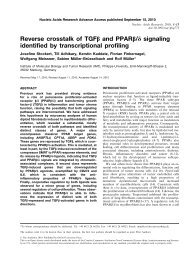


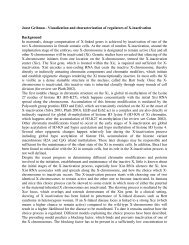
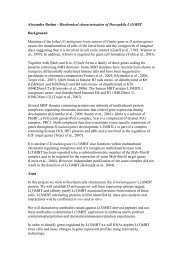
![2-(2-Bromophenyl)-3-{[4-(1-methyl-piperazine)amino]phenyl}](https://img.yumpu.com/22645635/1/190x248/2-2-bromophenyl-3-4-1-methyl-piperazineaminophenyl.jpg?quality=85)
